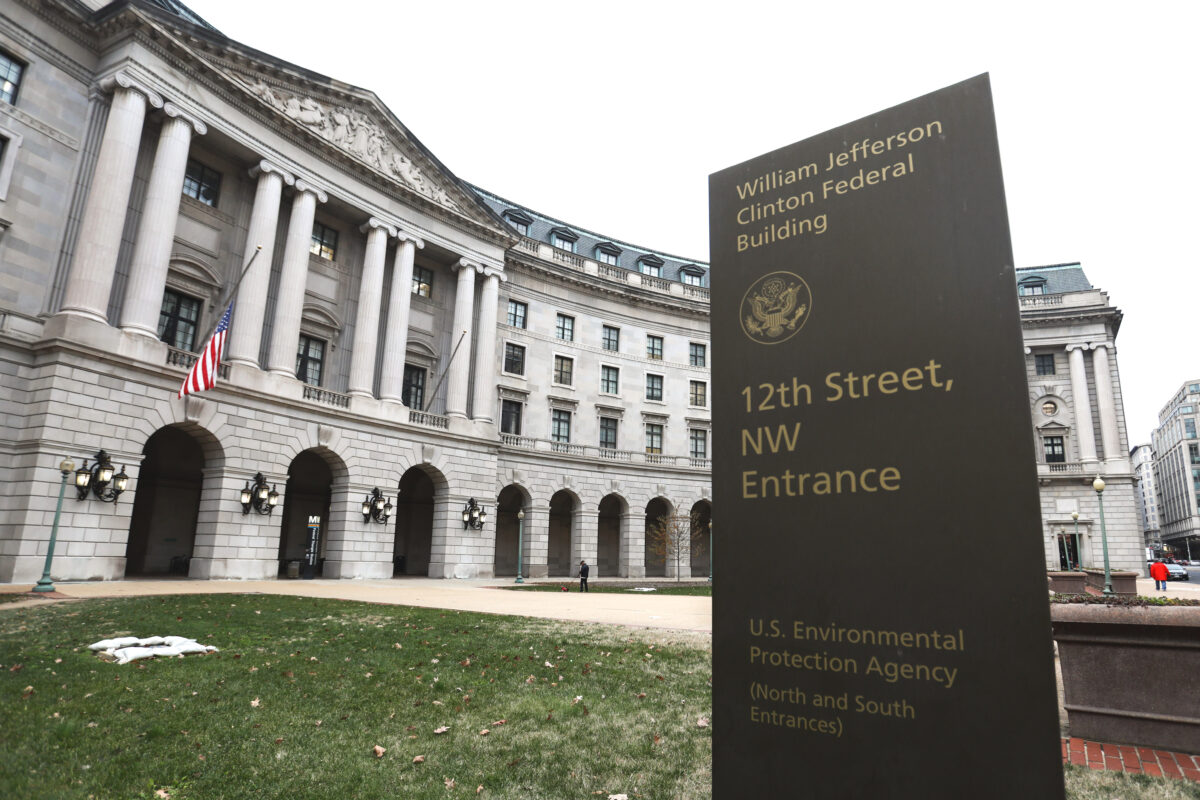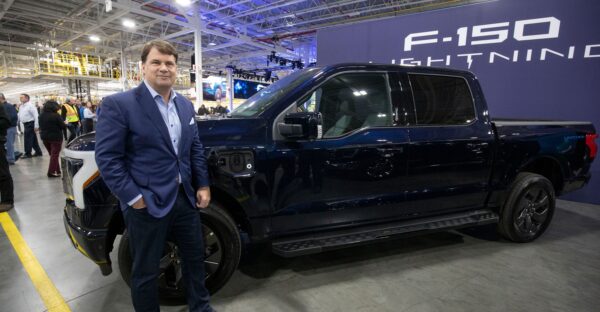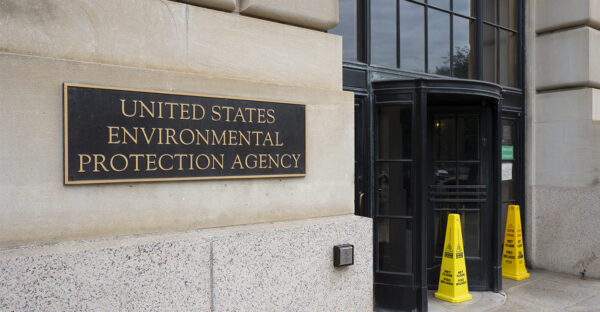


Two new Environmental Protection Agency (EPA) regulations that are currently being finalized will leverage the EPA’s authority to regulate emissions in order to force both America’s electricity network and America’s automotive industry to shift production to wind, solar, and electric vehicles (EVs).
However, new EPA initiatives targeting America’s fossil fuel industry will face legal challenges that will likely find their way to the Supreme Court and could result in landmark decisions about separation of powers in the United States, and the extent to which federal agencies, instead of elected officials in Congress, can assume broad lawmaking authority.
In April, the EPA announced new, significantly tighter standards on light-duty and medium-duty vehicles—starting in 2027. These new rules, the EPA said, would “leverage advances in clean car technology to unlock benefits to Americans, ranging from reducing climate pollution, to improving public health, to saving drivers money through reduced fuel and maintenance costs.”
The auto rules build on new EPA regulations to set tight emissions limits on power generation plants, forcing coal-fired plants either to close or install expensive and untested carbon-capture technology.
The EPA argues that, since Congress gave it the power to regulate emissions, it is simply carrying out this mandate. Critics say the EPA has gone beyond regulating emissions to crafting a national energy policy.
Federal agencies like the EPA “are way outside of their mandate set by Congress,” Joe Trotter, Energy, Environment, and Agriculture Task Force Director at the American Legislative Exchange Council, told The Epoch Times. “They do not, and should not, have the power to make huge sweeping changes to the American, and ultimately the global, economy through regulatory fiat.”
“The Biden administration has proposed tailpipe restrictions at levels that are so stringent that, by their own analysis, they can only be met if electric vehicles become the vast majority of cars sold in America,” O.H. Skinner, Executive Director of Alliance for Consumers, told The Epoch Times.
EVs are currently in demand by consumers who drive short distances, can charge them conveniently, and are wealthy enough to afford them. The average income of EV buyers is twice the median income in America, suggesting that EVs are the car of choice for rich Americans who live in or near cities.
“Rather than allow consumers to make choices, they’re just trying to force progressive lifestyle choices on everybody, no matter where they live, no matter how much money they make,” Skinner said. “It is very, very unpopular when you tell people they have to live life a certain way that doesn’t match how they want to live it. And I think even this administration recognizes that.
“So what they seem to be doing is demanding that manufacturers basically take away these choices. Their argument is, ‘We didn’t tell you you can’t buy a gas car, the manufacturers stopped making them,’” Skinner said.

Challenges to the EPA’s authority to mandate such sweeping changes, which are currently moving through the D.C. Circuit Court, will ultimately hinge on the court’s interpretation of what is called the “major questions” doctrine. This doctrine, set down most notably in the 2021 Supreme Court ruling, West Virginia v. EPA, states that questions of major importance to Americans must be decided by elected officials in Congress and not by federal agencies—unless Congress explicitly mandated that authority to an agency.
Skadden, a prominent law firm, advises its clients that “the Court’s approval of the ‘major questions’ doctrine signals a willingness to realign separation of powers in ways that restrict the administrative state.”
Skadden argues that the Supreme Court’s “distrust of agency action, combined with its interest in reviving the nondelegation doctrine” will lead to more legal challenges against agency authority, “but the argument won’t always gain traction.”
Support for the “major questions” doctrine is now split along party lines, with Republicans in favor and Democrats against. In December 2022, 16 GOP attorneys general filed a brief in D.C. courts challenging EPA authority on vehicle emissions. By contrast, in February 2023, 19 AGs from liberal states wrote in support of the EPA’s right to enact its new emissions standards on utilities.
Whether or not Congress gave the EPA the authority to set energy industrial policy or force an EV transition on automakers will be the essential question that judges will decide in the coming months. The courts have ruled on many such issues during the Biden administration in response to the administration’s habit of scouring Congressional mandates to find clauses that would give sweeping powers to federal agencies.
This includes mandating COVID vaccines under the guise of employee safety by Occupational Safety and Health Administration (OSHA), forgiving student loans by the Department of Education, and imposing mask mandates by the Centers for Disease Control and Prevention (CDC). All of these efforts were checked by federal courts, which ruled the Biden administration lacked the authority.
By its own admission, the Biden administration’s new auto emissions regulations are designed to boost the market share of EVs, effectively replacing internal combustion engines, and Congress has not given the EPA authority to manipulate markets in this way, critics say.
“Sometimes, this administration doesn’t learn its lesson the first time around,” Trotter said.
While challenges to the EPA regulations are likely from industry groups like corn growers associations, which produce biofuels for internal combustion engine (ICE) vehicles, the auto industry thus far has been reluctant to “fight City Hall.” Analysts can only speculate on motives, but venture to guess that this may be because automakers don’t want to be seen as climate deniers, would rather leave the fight to others, or that they relish the federal and state subsidies for investments in new battery assembly plants.
Whatever the case may be, the EV bet has proven costly for carmakers thus far.

An analysis by energy economist Robert Bryce found that Ford is currently losing more than $66,000 on every EV it sells. Ford’s announcement of $2.1 billion in total losses on its EVs for 2022 was double what it lost per vehicle in 2021, Bryce stated. And despite predictions that the cost of making EVs would fall, making them cheaper and more profitable, the cost of EV batteries went up by 7 percent last year.
EV sales have seen rapid growth in recent years from 2.6 percent of new-vehicle sales to 8.5 percent between 2020 and 2023, but that growth could soon hit a wall. Bryce cites a report by J.D. Power titled, “EV Divide Grows in U.S. as More New-Vehicle Shoppers Dig in Their Heels on Internal Combustion.” This report states that EV sales fell back to 7.3 percent in March 2023, and there has been a steady increase in consumers who say they are “very unlikely” to buy an EV because of cost and charging concerns.
“What we’re seeing is the Biden administration effectively trying to force automakers through regulation to produce more EVs, but there’s no evidence to suggest that consumers want to buy them,” Bryce told The Epoch Times. “We could be setting up a massive pileup here, with automakers spending billions to produce cars that the vast majority of consumers don’t want.”
In addition to betting on consumer demand that may not be there, automakers may be choosing a bad time to invest billions into new manufacturing plants.
“All of this is happening at the same time that interest rates are rising and the signs of a recession are very clear,” Bryce said. “Consumers are spending less money and keeping their existing automobiles longer. That could result in a further slowdown across the automotive sector and across the economy, not just for EVs.”
Some speculate that automakers are not opposing the EPA rules because, given that they are impossible to meet, the limits and deadlines ultimately will not be enforced.
A report by the Cato Institute titled, “Electric Cars: Policy Beyond Capability?” states that “the unrealistic nature of the [EPA] proposal is actually a persistent characteristic of environmental policy.” Noting that the EPA standards would require 67 percent of new cars to be EVs by 2032, the Cato report states that data from the Energy Information Administration projects that EV sales will still be less than 20 percent of the market by 2050. In addition to shortfalls in demand, the ability of carmakers to source the minerals they need to make EVs in such large numbers is questionable.
“It’s just not realistic to have all these goals happen the way they’re being laid out,” Trotter said. “You’ve seen huge increases in the prices of things like lithium, copper, and aluminum, which are all necessary to make electric vehicles. Far more of it is needed for EVs than for traditional cars.

“There aren’t huge increases in supply to make up for the increase in demand,” he said.
According to the Cato report, when policies like the new EPA emissions standards prove impossible for companies to implement, Congress often “quietly” steps in, taking action like cutting funding to specific agencies to “restrict their ability to implement unrealistic regulations.”
“The retreat from unrealism will probably be quiet,” the report states.
“But if motorists can’t buy the cars they want, the retreat will be visible and rapid.”
